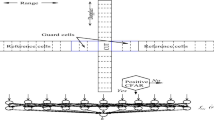Abstract
The use of convolutional neural networks (CNN’s) for radar detection is evaluated. The detector includes a time-frequency block that has been implemented by the Wigner-Ville distribution and the Short-Time Fourier Transform to test the suitability of both techniques. The CNN detectors are compared with the classic multilayer perceptron and with several traditional non-neural detectors. Preliminary results are shown using non-correlated and correlated Rayleigh-envelope clutter.
Access this chapter
Tax calculation will be finalised at checkout
Purchases are for personal use only
Preview
Unable to display preview. Download preview PDF.
Similar content being viewed by others
References
J.L. Eaves and E.K. Reedy, editors. Principles of Modern Radar. Van Nostrand Reinhold Company, 1987.
S. Haykin and J. Principe. Making sense of a complex world. IEEE Signal Processing Magazine, 15(3):66–81, March 1998.
S. Haykin and T. K. Bhattacharya. Modular Learning Strategy for Signal Detection in a Nonstationary Environment. IEEE Trans. on Signal Processing, 45(6):1619–1637, June 1997.
Y. Lecun, L. Bottou, Y. Bengio, and P. Haffner. Gradient-Based Learning Applied to Document Recognition. Proceedings of the IEEE, 86(11):2278–2324, November 1998.
S. Haykin. Neural Networks. A Comprehensive Foundation. Prentice Hall, 2nd edition, 1999.
F. Hlawatsch and G. F. Boudreaux-Bartels. Linear and Quadratic Time-Frequency Signal Representations. IEEE Signal Processing Magazine, pages 21–67, April 1992.
D. Andina and J. L. Sanz-González. Comparison of a Neural Network Detector vs Neyman-Pearson Optimal Detector. In IEEE International Conference on Acoustic, Speech and Signal Processing, pages 3573–3576, 1996.
M. I. Skolnik. Introduction to Radar Systems. McGraw-Hill, 2nd edition, 1980.
Author information
Authors and Affiliations
Editor information
Editors and Affiliations
Rights and permissions
Copyright information
© 2002 Springer-Verlag Berlin Heidelberg
About this paper
Cite this paper
López- Risueño, G., Grajal, J., Haykin, S., Díaz-Oliver, R. (2002). Convolutional Neural Networks for Radar Detection. In: Dorronsoro, J.R. (eds) Artificial Neural Networks — ICANN 2002. ICANN 2002. Lecture Notes in Computer Science, vol 2415. Springer, Berlin, Heidelberg. https://doi.org/10.1007/3-540-46084-5_186
Download citation
DOI: https://doi.org/10.1007/3-540-46084-5_186
Published:
Publisher Name: Springer, Berlin, Heidelberg
Print ISBN: 978-3-540-44074-1
Online ISBN: 978-3-540-46084-8
eBook Packages: Springer Book Archive




